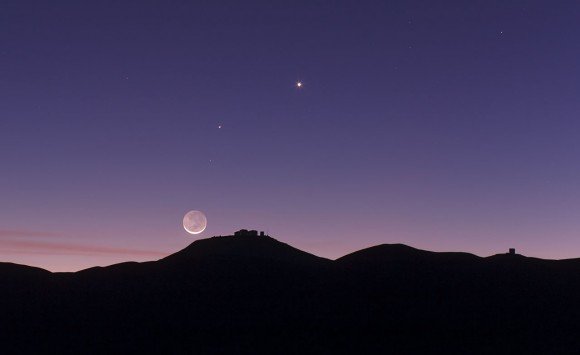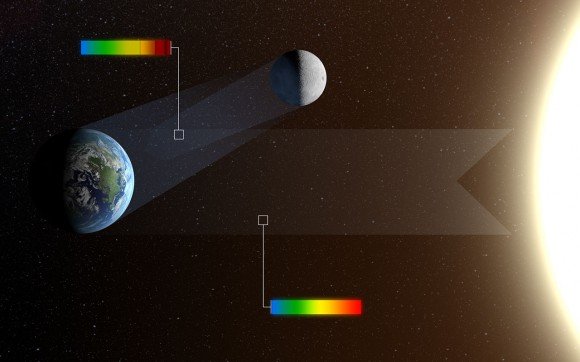C reative
Particle
Higgs
CPH Theory is based on Generalized light velocity from energy into mass.
CPH Theory in Journals
|
Life in the Universe, Reflected by the Moon
|
|
Life in the Universe, Reflected by the Moon
This view shows the thin crescent Moon setting over ESO’s Paranal Observatory in Chile. Credit: ESO/B. Tafreshi/TWAN
Earthshine – a poetic, fanciful word for the soft, faint glow on the Moon when the light from the Sun is reflected from the Earth’s surface, onto the dark part of the Moon. And as unlikely as it might seem, astronomers have used Earthshine to verify there’s life in the Universe: Us. While we already know about life on our own world, this technique validates that faint light from distant worlds could also be used to find potential alien life.
“We used a trick
called earthshine observation to look at the Earth as if it were
an exoplanet,” said Michael Sterzik from the European Southern
Observatory. “The Sun shines on the Earth and this light is
reflected back to the surface of the Moon. The lunar surface
acts as a giant mirror and reflects the Earth’s light back to us
— and this is what we have observed with the VLT (Very Large
Telescope).” Looking at earthshine, they found strong bio-signatures such as molecular oxygen and methane, as well as the presence of a ‘red edge’ caused by surface vegetation.
By observing earthshine astronomers can study the properties of light reflected from Earth as if it were an exoplanet and search for signs of life. The reflected light is also strongly polarised and studying the polarisation as well as the intensity at different colours allows for much more sensitive tests for the presence of life. Credit: ESO/L. Calçada
Instead of just looking at the planet’s reflected light, astronomers can also use spectropolarimetry, which looks at the polarization of the light. Using this approach, the biosignatures in the reflected light from Earth show up very strongly. “The light from a distant exoplanet is overwhelmed by the glare of the host star, so it’s very difficult to analyze — a bit like trying to study a grain of dust beside a powerful light bulb,” said co-author Stefano Bagnulo from Armagh Observatory in Northern Ireland. “But the light reflected by a planet is polarised, while the light from the host star is not. So polarimetric techniques help us to pick out the faint reflected light of an exoplanet from the dazzling starlight.” By looking at earthshine, the team was able to deduce that the Earth’s atmosphere is partly cloudy, that part of its surface is covered by oceans and — crucially — that there is vegetation present. They could even detect changes in the cloud cover and amount of vegetation at different times as different parts of the Earth reflected light towards the Moon. “These observations allow us to determine the fractional contribution of clouds and ocean surface, and are sensitive to Spectropolarimetry unveils strong biosignatures, visible areas of vegetation as small as 10%,” the team wrote in their paper. “Finding life outside the Solar System depends on two things: whether this life exists in the first place, and having the technical capability to detect it,” said co-author Enric Palle from Instituto de Astrofisica de Canarias, Tenerife, Spain. “This work is an important step towards reaching that capability.” “Spectropolarimetry may ultimately tell us if simple plant life — based on photosynthetic processes — has emerged elsewhere in the Universe,” said Sterzik. “But we are certainly not looking for little green men or evidence of intelligent life.” The astronomers said that future telescopes such as the E-ELT (the European Extremely Large Telescope), could provide more detail about the type of life beyond planets that may exists on another world.
Read the team’s paper, Download
which was published in Nature.
Source: ESO
1 2 3 4 5 6 7 8 9 10 Newest articles
|
|
Sub quantum space and interactions from photon to fermions and bosons |
Interesting articles
Since 1962 I doubted on Newton's laws. I did not accept the infinitive speed and I found un-vivid the laws of gravity and time.
I learned the Einstein's Relativity, thus I found some answers for my questions. But, I had another doubt of Infinitive Mass-Energy. And I wanted to know why light has stable speed?


